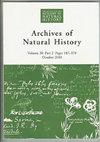“博德利板”上的自然历史图像的新鉴定,这是一种18世纪早期的雕刻铜板
IF 0.3
4区 哲学
Q3 HISTORY & PHILOSOPHY OF SCIENCE
引用次数: 0
摘要
“Bodleian Plate”是一种18世纪早期的雕刻铜版,上面有一系列美国弗吉尼亚州威廉斯堡的建筑图像,以及植物和动物的描绘。其中四幅自然历史图像描绘了这里的海藻碎片,被鉴定为马尾藻属(马尾藻科)和结节叶藻(岩藻科)。第五个植物学主题被鉴定为Tilia sp.(锦葵科)花序的片段。马尾藻的两个片段显示了共生海洋生物,一种苔藓虫(可能是疣水母(膜足纲))和鹅藤壶(Lepas sp.(甲壳纲;Circripedia))。还描绘了海马(Hippocampus sp.(Syngnathidae))、地甲虫和蜘蛛。这些新的鉴定与以下假设相矛盾,即插图描绘了18世纪初弗吉尼亚州具有重要金融意义的农业或其他商品。自然历史图像并不支持与弗吉尼亚州Westover的William Byrd II之间的假定联系。本文章由计算机程序翻译,如有差异,请以英文原文为准。
New identifications of natural history images on the “Bodleian Plate”, an early eighteenth-century engraved copperplate
The “Bodleian Plate”, an early eighteenth-century engraved copper printing plate, bears a series of images of buildings erected in Williamsburg, Virginia, USA, as well as depictions of plants and animals. Four of these natural history images portray fragments of marine algae here identified as Sargassum spp. (Sargassaceae) and Ascophyllum nodosum (Fucaceae). A fifth botanical subject is identified as fragments of the inflorescences of Tilia sp. (Malvaceae). Two of the Sargassum fragments show commensal marine organisms, a bryozoan (probably Jellyella tuberculata (Membraniporidae)) and goose barnacles ( Lepas sp. (Crustacea; Cirripedia)). A seahorse ( Hippocampus sp. (Syngnathidae)), a ground beetle and a spider are also depicted. These new identifications contradict the hypothesis that the illustrations portray agricultural or other commodities of financial importance in Virginia during the early 1700s. A putative link with William Byrd II of Westover, Virginia, is not supported by the natural history images.
求助全文
通过发布文献求助,成功后即可免费获取论文全文。
去求助
来源期刊

Archives of Natural History
HISTORY & PHILOSOPHY OF SCIENCE-
CiteScore
0.40
自引率
50.00%
发文量
34
审稿时长
>12 weeks
期刊介绍:
Archives of Natural History (formerly the Journal of the Society for the Bibliography of Natural History) publishes peer-reviewed papers on the history and bibliography of natural history in its broadest sense, and in all periods and all cultures. This is taken to include botany, general biology, geology, palaeontology and zoology, the lives of naturalists, their publications, correspondence and collections, and the institutions and societies to which they belong. Bibliographical papers concerned with the study of rare books, manuscripts and illustrative material, and analytical and enumerative bibliographies are also published.
 求助内容:
求助内容: 应助结果提醒方式:
应助结果提醒方式:


